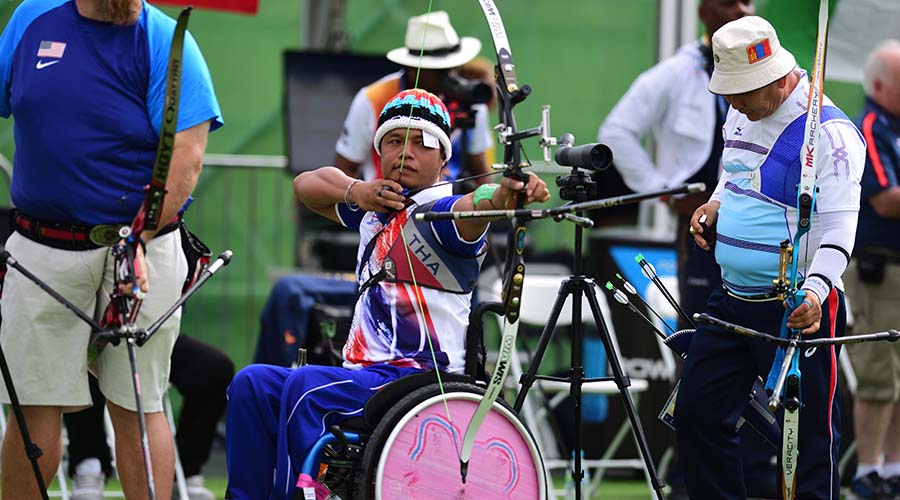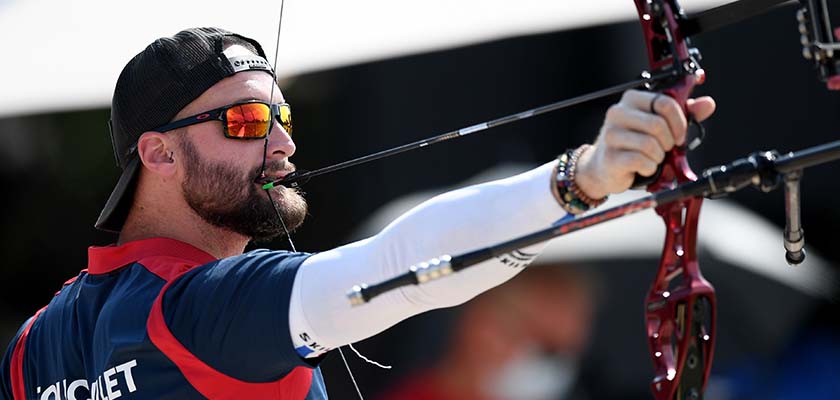Resilience, determination and a lot of skill. Find out everything about paralympic archery, practiced by athletes with physical or neurological disabilities, who find in sport not only a way to compete, but also to overcome challenges and inspire the world.
Paralympic archery is an adapted version of the sport of shooting, and just like the conventional version, the aim is to hit targets at different distances.
We can consider the sport in question as an important part of the Paralympic Games, an international sporting competition aimed at athletes with disabilities that takes place immediately after the Olympic Games and is governed by the International Paralympic Committee (IPC).
Participe da nossa comunidade gratuita no WhatsApp e receba diariamente dicas, notícias e curiosidades de mais de 50 esportes! Clique aqui para participar.
Everything about paralympic archery: when did it come about?
Paralympic archery emerged between the 1940s and 1950s, mainly after the Second World War. This was because many disabled war veterans wanted to get involved in sporting activities.

At international level, organized competitions began to gain prominence in the 1960s.
When did archery enter the Paralympic Games?
Paralympic archery entered the Paralympic Games in 1960 in Rome (Italy) and has become increasingly popular ever since, with more countries taking part and more athletes getting involved in the competition every year.
All about paralympic archery: classes
And since we’re talking all about paralympic archery, it’s worth mentioning that athletes are divided into three groups of classes, which are differentiated by the athlete’s ability to stand and/or move their arms and torso: W1 and W2, OPEN (recurve and compound bows) and V1, V2 and V3. Below, you’ll find details of everything about paralympic archery (classes):
Recurved Arc
The most traditional category of archery, where archers use recurve bows, which have curved limbs that form a “recoil” when the string is pulled.
The Recurve Arc in Paralympic archery involves athletes with a disability in one limb (upper or lower) or in two limbs (lower or upper and lower on the same side).
Composite Arc
In this category, archers use compound bows, which have a pulley system that helps to reduce the force needed to hold the string.
As with the recurve bow, the compound bow in paralympic archery also involves athletes with disabilities in one or two limbs, upper or lower.
Arch W1
The W1 bow in paralympic archery is aimed at archers who compete in wheelchairs and have significant functional limitations in their upper limbs, such as severe paralysis or bilateral amputations above the elbow. W1 archers can use recurve or compound bows.
W2 Arch
This category is similar to W1, but is for archers with fewer functional limitations in their upper limbs. W2 archers also compete in wheelchairs, but have greater upper limb functionality compared to W1 archers.
Open Arc V1, V2 and V3
Esta é uma categoria específica para arqueiros com deficiências visuais. Os arqueiros nesta categoria utilizam arcos recurvos e têm uma marca tátil no arco para ajudá-los na orientação durante o tiro.
Is paralympic archery a team sport?
Paralympic archery involves individual, pair and team competitions, with three archers on each team.
In either case, the participants aim to hit the arrows as close as possible to the center of the target, which is placed at a distance of 70m and has a diameter of 1.22m, formed by ten circles.
All about paralympic archery: disabilities
According to the Brazilian Paralympic Committee, the eligible conditions for a person to practice Paralympic archery include:
- Paraplegia
- Tetraplegia and equivalent
- Amputation and equivalent
- Cerebral palsy
- Dysfunctional diseases (such as muscle atrophy and sclerosis)
- Joint dysfunctions
- Back problems
- Multiple disabilities
- Visually impaired (but does not enter the Paralympic Games)
All about paralympic archery: adaptations
Although archery and paralympic archery share many similarities, there are some significant differences, especially in terms of adaptations to accommodate the needs of disabled athletes.
In Paralympic archery, equipment can be adapted and modified to be operated by athletes in wheelchairs, and specific aiming devices can be used for visually impaired archers.
In addition, as we have seen, there are different categories of competition to accommodate a variety of disabilities.
Shooting positions can also be adapted in Paralympic archery to accommodate athletes’ needs, with the right supports or braces to help with stability during the shot.

Top Paralympic archery athletes
There are several Paralympic archery athletes who have excelled in competitions and inspired the public, such as:
- Zahra Nemati (Irã)
- Matt Stutzman (United States)
- Nur Syahidah Alim (Singapore)
- Eric Bennett (United States)
- Jane Karla Gögel (Brazil)
Zahra Nemati
Zahra Nemati has competed in both the Paralympic and Olympic Games, and is known for winning gold medals in several Paralympic competitions.
Matt Stutzman
The American became known as the “Armless Archer” due to a congenital condition that resulted in the absence of arms. He is a Paralympic medalist and world record holder.
Eric Bennett
The American archer who competed in several editions of the Paralympic Games, winning multiple gold medals.
Kevin Mather
The British archer has competed in several Paralympics, winning gold, silver and bronze medals throughout his career.
Nur Syahidah Alim
The Singaporean archer who competed at the 2020 Paralympic Games in Tokyo, winning a gold medal in the compound bow category.
Jane Karla Gögel
Brazilian Jane Karla Gögel has already competed in three Paralympic Games: 2008 in Beijing, 2012 in London and 2016 in Rio de Janeiro.
Knowing everything about paralympic archery helps us understand more about the human capacity to overcome physical challenges and limitations. The inspiring stories of paralympic athletes also contribute to raising awareness about inclusion. Follow the content on this and other sports on our website:





